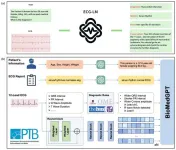(Press-News.org)
A team of researchers from Tsinghua University and Beijing Tsinghua Changgung Hospital has introduced a cutting-edge method to improve the interpretation of electrocardiogram (ECG) data. Their innovative model, called ECG-LM, leverages the power of large language models (LLMs) to interpret complex ECG signals more effectively and accurately. The groundbreaking research was published in Health Data Science, offering a transformative approach that promises to revolutionize heart-related diagnostics.
Electrocardiograms (ECGs) are one of the most widely used tools in clinical settings to monitor heart health, providing essential insights into the functioning of the cardiovascular system. However, despite their widespread use, the interpretation of ECG data remains a challenging task. Accurate analysis often requires significant medical expertise and resources, and even small errors can lead to serious misdiagnoses. This is particularly true in settings with a shortage of trained cardiologists, where manual analysis can be slow and inefficient.
While deep learning techniques have made strides in the realm of ECG interpretation, the need for a more integrated and efficient model that can analyze both ECG data and patient information simultaneously has remained a significant challenge. This is where the ECG-LM model makes its mark, as it combines state-of-the-art machine learning techniques with large language models to address these gaps.
The ECG-LM model developed by researchers from Tsinghua University is a major leap forward in the use of artificial intelligence for healthcare. By utilizing a large language model (LLM), ECG-LM can interpret and understand ECG data in conjunction with patient-specific information, such as medical history, symptoms, and other relevant data. This integrated approach allows the model to provide more accurate, contextually aware diagnoses of heart conditions.
The researchers applied deep learning to develop a model that could identify subtle ECG patterns that might be missed by traditional methods. The model was trained on an extensive dataset of ECG readings paired with clinical data, enabling it to detect correlations between the ECG signal and broader health trends. This allows for better identification of arrhythmias, heart attacks, and other cardiovascular issues, even in early stages when symptoms may not yet be obvious.
In extensive testing, the ECG-LM model showed significant improvements over traditional diagnostic tools. It was able to process ECG readings faster and more accurately, with the ability to suggest probable diagnoses based on a variety of patient data. The team demonstrated that ECG-LM is not only accurate but also more efficient than existing models, making it a valuable tool for healthcare professionals working in both resource-limited and high-volume environments.
Dr. Zaiqing Nie, the lead researcher and professor at Tsinghua University, emphasized the broader impact of their findings. "This research represents a pivotal moment in the field of cardiovascular medicine," said Dr. Nie. "By using the power of large language models, we can make ECG interpretation faster, more accurate, and more accessible to healthcare providers worldwide, potentially saving countless lives."
The ECG-LM model has the potential to democratize access to advanced heart disease diagnostics, particularly in underserved regions where access to specialized medical professionals is limited. By automating much of the diagnostic process, healthcare providers can focus more on patient care, ultimately improving outcomes for individuals with heart conditions.
While the ECG-LM model has already demonstrated promising results, the research team is far from finished. Moving forward, they plan to refine the model further by incorporating additional data sources and improving the model’s interpretability. The goal is to make the system even more user-friendly for clinicians and to expand its application to other areas of healthcare where large-scale data analysis can have an impact.
The researchers are also exploring potential collaborations with hospitals and healthcare providers to test the system in real-world clinical settings, ensuring that the model is ready for widespread deployment. "Our future work will focus on enhancing the model’s adaptability and interpretability, making it an indispensable tool for medical professionals," Dr. Nie explained.
With the development of ECG-LM, the team from Tsinghua University and Beijing Tsinghua Changgung Hospital is at the forefront of a new era in cardiovascular diagnostics. By harnessing the capabilities of large language models, their work represents a significant breakthrough in the way ECG data is understood and applied in clinical settings, promising to improve the accuracy, speed, and accessibility of heart disease diagnosis worldwide.
END
About The Study: In a representative study of adults experiencing homelessness in California, there was a high proportion of current drug use, history of overdose, and unmet need for treatment. Improving access to treatment tailored to the needs of people experiencing homelessness could improve outcomes.
Corresponding Author: To contact the corresponding author, Ryan D. Assaf, PhD, MPH, email ryan.assaf@ucsf.edu.
To access the embargoed study: Visit our For The Media website at this link https://media.jamanetwork.com/
(doi:10.1001/jama.2024.27922)
Editor’s Note: Please see the article for additional information, including other authors, ...
About The Study: The findings of this study suggest that it is possible to predict diagnostic transition to schizophrenia and bipolar disorder from routine clinical data extracted from electronic health records, with schizophrenia being notably easier to predict than bipolar disorder.
Corresponding Author: To contact the corresponding author, Lasse Hansen, MSc, PhD, email lasse.hansen@clin.au.dk.
To access the embargoed study: Visit our For The Media website at this link https://media.jamanetwork.com/
(10.1001/jamapsychiatry.2024.4702)
Editor’s Note: Please see the article for additional information, including other authors, author contributions ...
U.S. hospital occupancy after the end of the Covid-19 pandemic is significantly higher than it was before the pandemic, setting the stage for a hospital bed shortage as early as 2032, new research suggests.
In the decade leading up to the pandemic, U.S. average hospital occupancy was approximately 64%. In a study to be published in the peer-reviewed journal JAMA Network Open, the team of UCLA researchers found that the new post-pandemic national hospital occupancy average is 75% -- a full 11 percentage points ...
About The Study: The U.S. has achieved a new post-pandemic hospital occupancy steady state 11 percentage points higher than it was pre-pandemic. This persistently elevated occupancy appears to be driven by a 16% reduction in the number of staffed U.S. hospital beds rather than by a change in the number of hospitalizations. Experts in developed countries have posited that a national hospital occupancy of 85% constitutes a hospital bed shortage (a conservative estimate). The findings of the current study show that the U.S. could reach this dangerous threshold as soon as 2032, with some ...
About The Study: After more than 10 years of follow-up in the Swiss Multicenter Bypass or Sleeve Study randomized clinical trial, Roux-en-Y gastric bypass demonstrated superiority over sleeve gastrectomy for patient excess body mass index loss.
Corresponding Author: To contact the corresponding author, Ralph Peterli, MD, email ralph.peterli@clarunis.ch.
To access the embargoed study: Visit our For The Media website at this link https://media.jamanetwork.com/
(doi:10.1001/jamasurg.2024.7052)
Editor’s Note: Please see the article for additional information, including other authors, author ...
In the next five years, integrating AI into country response systems could save more lives by anticipating the location and trajectory of disease outbreaks.
Global group of researchers call for better collaboration between academia, government and industry, to ensure safety, accountability and ethics in the use of AI in infectious disease research.
A study published in Nature today outlines for the first time how advances in AI can accelerate breakthroughs in infectious disease research and outbreak response.
The study – which ...
In the face of the alarming number of opioid-related deaths in the U.S., there have been national efforts to increase emergency clinician prescribing of buprenorphine, a medication used to treat opioid use disorder. In a new study published in JAMA, UCLA Health researchers report on the extent and success rate of such efforts in California.
Opioid-related emergency department (ED) visits, hospitalizations, and deaths have increased markedly since 1999, and the growing number of cases was declared a public health emergency in 2024. Combined ...
Expert sommeliers can take a whiff of a glass of wine and tell you a lot about what’s in your pinot noir or cabernet sauvignon.
A team of physicists at CU Boulder and the National Institute of Standards and Technology (NIST) have achieved a similar feat of sensing, only for a much wider range of substances.
The group has developed a new laser-based device that can take any sample of gas and identify a huge variety of the molecules within it. It is sensitive enough to detect those molecules at minute concentrations all the way down to parts per trillion. ...
At a glance:
Study in mice offers insights into the brain circuitry underlying certain types of reward-based choices.
Researchers identified distinct groups of brain cells activated when animals anticipate a reward to be above average or below average for a choice.
The findings enhance understanding of human decision-making and how the brain balances risk and reward.
Every day, our brain makes thousands of decisions, big and small. Any of these decisions — from the least consequential such as picking ...
Immune therapy has transformed how cancer is treated, but many tumors continue to evade these treatments, thanks to their resemblance to healthy tissue.
Now, researchers at UC San Francisco have found that some cancers, like deadly brain cancer (glioma), make unique, jumbled proteins that make them stand out. These newly recognized cancer-specific proteins, or antigens, could speed the development of potent immunotherapies that recognize and attack hard-to-treat tumors.
The study, which was supported through grants from the National Institutes of Health, appears in Nature on ...

